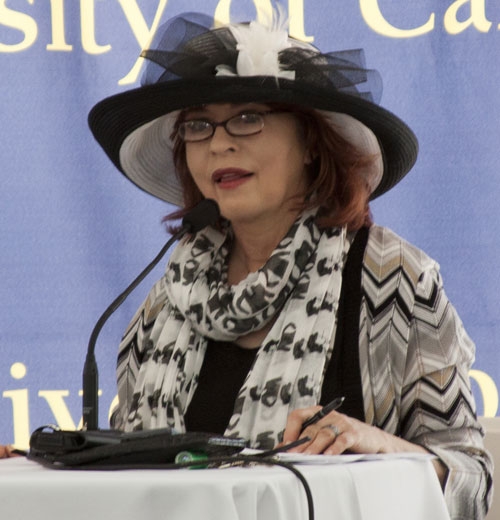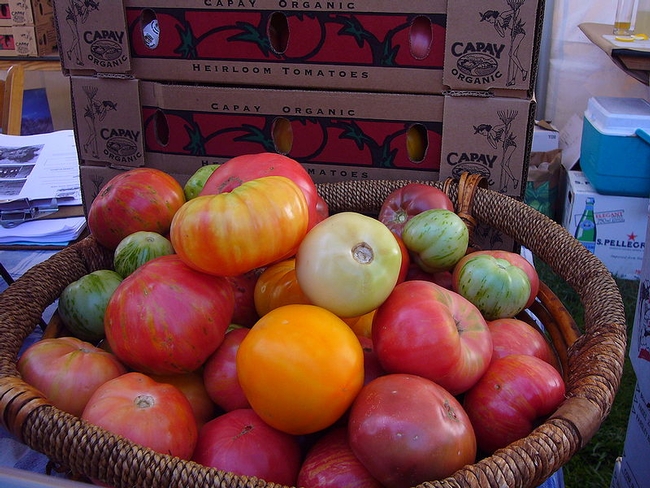
Posts Tagged: Morrill Act
NPR talks about land grant universities

Sara from Fresno called into the show to explain the role of UC Cooperative Extension. She said: "...we use the extension service to help us determine what kinds of things we can use to keep the crop healthy, not just pesticides, but how to check the crops and to make sure that they're healthy. They use independent research all the time to help us with this. And with the public funds just dwindling, we have a lot less independent research that go on and have to go on more of what the chemical companies are telling us."
When asked for an example, according to the show's transcript, Sara said: "Well, I'm looking at a cotton crop right now, and the farmer advisers, the cotton farmer advisors in California, helped us what the program called plant mapping, where we were able to take a look at what's going on with the plant even though we might have bugs out that could be damaging the crops."
Sandy Rikoon, professor of rural sociology at the University of Missouri, told listeners, "Many countries are trying to duplicate the extension system. Many countries have research, agricultural research, but what they don't have is that group of people who take the research and then take it to the people."
Host Neal Conan mistakenly said the California State University is one of the land grants and we have asked NPR to correct the online version to state that UC is California's land grant institution.
UC marks 150th anniversary of the Morrill Act

Los Angeles Times reporter Patt Morrison moderated a panel discussion at the event, and wrote a post about the Morrill Act sesquicentennial on the newspaper's Opinion L.A. blog today.
Morrison asked Abraham Lincoln, portrayed at the event by lanky Sonoma County teacher Roger Vincent, "President Lincoln - the opportunity for every American to go to college? Really?" He nodded.
"'What a snob,' I remarked," Morrison wrote in her post, a reference, she said, to former senator and former Republican presidential candidate Rick Santorum gibing at President Obama’s goal of making a college education available to all Americans.
When Lincoln was president, 50 percent of Americans were involved in producing food. A steady movement away from the occupation has created significant challenges and opportunities for the agriculture industry.
"Americans may be even more aware of what they eat, the panelists noted, with the growth of popularity of organic foods and health-conscious diets like First Lady Michelle Obama’s, but even less aware of where food comes from and how it gets from field to plate," Morrison wrote.
Yudof and UC Cooperative Extension advisor Rose Hayden-Smith, a historian and leader of ANR's Sustainable Farming Systems Strategic Initiative, made speeches. The texts of their presentations are linked below.
Heirlooms, civic agriculture and a New Year's resolution

“Heirloom” is an interesting term, and like the word “sustainability,” it means different things to different people. Recently, I read The Heirloom Life Gardener, a book written by Jere and Emilee Gettle. The Gettles are the co-founders of the Baker Creek Heirloom Seed Company, which publishes a lush and incredibly informative seed catalog and has spun off a variety of gardening-related enterprises across the nation. The Gettles define heirloom seeds as being “nonhybrid and open-pollinated” and as usually having been in circulation for more than 50 years. Some heirloom seed types currently in use could have been found in Thomas Jefferson garden at Monticello. Some appear more recently, during the Great Depression, including the Mortgage Lifter tomato (who couldn’t use one of these in today’s economy?).
While reading the Gettles’ book, I began thinking once again about the relationship between land and the American character. I was inspired to pull some of my favorite books off the shelf and revisit them, to consider the notion of “civic agriculture.”
The term “civic agriculture” - coined by the former Thomas Lyson of Cornell - is used by some to refer to the movement towards locally based agricultural models that tightly link community, social and economic development. Models of civic agriculture include CSAs, farmer’s markets, roadside stands, urban agriculture, community gardens, and farm-to-school/farm-to-institution programs. I also argue that civic agriculture includes school and home gardens . . . any place where people seek to connect land to the development of community or as an expression of engagement or citizenship.
The civic aspect of agriculture is much older than the current local food movement; it hearkens back to our nation’s founding. The connection between land and democracy has always held real meaning in American culture. Jeffersonian ideals about the civic virtues and value of gardening and agriculture were prevalent and shaped American cultural and political life; the U.S. Department of Agriculture, created in 1862, was called “The People’s Department” by President Abraham Lincoln. Lincoln once told a group of Wisconsin farmers that as long as Americans knew how to cultivate even the smallest plot of land, that the nation’s citizens would be free from kings and moneylenders, free from oppression of all sorts.
Federal legislation such as the Morrill Act (we will celebrate its sesquicentennial in 2012, and I'll be writing about that throughout the New Year) created America’s land-grant institutions, which still have as a primary purpose research and education in support of the nation’s agricultural producers. (Land-grant institutions through their Master Gardener programs also support home and community gardeners). The Homestead Act, also passed in 1862, and linked the cultivation of land to the protection of the Union and the expansion of democracy during the nation’s Civil War. You’ve heard this from me more than once: We were a nation of farmers at origin; we are still a nation of farmers at heart.
We farm, and we garden. Gardening links the myth and the practice of agriculture to one another. In practice, gardening is agriculture on a personal scale; it represents an individual's relationship to a specific piece of land. This is a kind of relationship worth investing in.
As the longest, darkest days of the year are upon us, as you celebrate the best things that family and hearth offer, and as you formulate your goals and hopes for the New Year, I hope that you’ll consider adding another resolution to your list: to embark upon a gardening activity, no matter how small, in 2012. Occupy the possibilities that gardens create at our homes, and in our communities.
Happy Holidays, and a Healthy and Prosperous New Year.
“A Garden for Everyone. Everyone in a Garden.”
